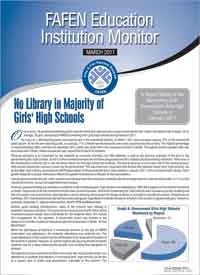A Report Based on the Monitoring of 61 Government Girls High Schools in February 2011
ISLAMABAD, April 04, 2011: One in every 10 sanctioned teaching posts in monitored government girls’ high schools is lying vacant nationwide, where one teacher has to teach, on an average, 33 girls. Among the monitored schools, 55% did not have a library and 43% had no playgrounds. The government needs to ensure the availability of staff and facilities for the education of female students in the country, says FAFEN Education Monitor released here Monday.
FAFEN Governance Monitors visited 61 government girls’ high schools in 46 districts across the country in February 2011. As many as 36 schools were visited in 25 districts of Punjab, 12 in 11 districts of Sindh, 11 in eight districts of KP and two in as many districts of Balochistan.
As many as 1,493 teaching posts were sanctioned in the monitored schools, of which 1,347 were occupied, leaving 10% of the sanctioned posts vacant. As for the non-teaching posts, on average, 11% of the sanctioned posts were lying vacant across the country. The highest percentage of vacant teaching (29%) and the non-teaching (18%) posts was observed in the monitored schools of Sindh. The highest teacher-student ratio was also observed in Sindh, where one teacher was responsible to teach 45 students.
Physical education is as important for the students as curricular activities, but little attention is paid to the physical activities of girls in government girls’ high schools, as 43% of the monitored schools did not have playgrounds and 36% lacked a physical training instructor. Thirty-four of the monitored 61 schools (55%) did not have a library for the high school girl students. This becomes more important in light of the fact that relatively lesser boys’ high schools, run by the state, lack a library. According to FAFEN observation of 50 government boys’ high schools in January 2011, 62% of schools had a library. Such gender disparity in similar institutions reflects the gender insensitivity on the part of the policymakers.
Like playgrounds and libraries, many schools were lacking even the basic amenities like arrangements for clean drinking water. In 11% of the monitored schools, no such arrangements were in place.
However, general building and sanitation conditions in the monitored girls’ high schools were satisfactory. With the exception of one school monitored in Sindh, classrooms of all the monitored schools were found to be clean. Almost all monitored girls’ high schools were housed in a proper building and had a boundary wall around them. Despite secure buildings, 43% monitored schools did not have a security guard, despite constant threats to schools in the country in general and girls’ schools in particular, especially in regions under conflict, like KP, FATA, and Balochistan.
Despite good building infrastructure, around one fourth (23%) of the monitored schools lacked chairs and tables for students while 16% lacked this arrangement for teachers. A black/whiteboard was present in the classrooms of all the monitored schools except one each in Sindh, KP, and Balochistan.
While the attendance of teachers in monitored schools on the day of FAFEN observation was satisfactory, the students’ attendance was relatively low. The lower attendance of the students can be attributable to the weak administration of the schools in general. However, in conflict regions, the security threats to female students may be a factor deterring the parents from sending their daughters to schools.
The absence of many essential facilities and issues like vacant posts and/or low attendance of students and teachers in monitored girls’ high schools can be due to a severe lack of public and government oversight of the schools. The administration of 61 schools reported only 28 visits by the government officials and elected representatives in last three calendar months (November 2010, December 2010 and January 2011). Such a weak oversight was evident in all the regions but it was more worrying in Sindh where not a single visit was made by any government or elected official in any of the 12 monitored girls’ high schools.
To download complete report, click here



